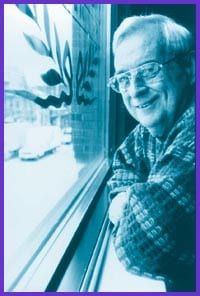Toronto gay activist George Hislop started going to bathhouses in the 1940s.
When the Spa On Maitland was fighting the city to open in 1989, Hislop was asked to submit an affidavit on the Spa’s behalf and the court accepted him as a recognized authority on steam baths, “a habitué of those places.” Now he’s got his own room at the Spa, complete with a bookshelf filled with tchotchkes.
We asked Hislop how bathhouse culture has changed over the decades. Here’s an edited version of the conversation.
***
Back in 1948, I remember going to the Oak Leaf Steam Baths [which still exists at 216 Bathurst St]. You’d have sex there, discreetly. We had a tacit agreement that we didn’t go into the straight areas and they didn’t come into ours.
Prior to the late ’60s, the bathhouses were straight owned, catering to a middle European clientele. That’s what the Oak Leaf was. Back then, the Oak Leaf was never raided and there were questions at the time why it wasn’t. At other places, police would send in agent provocateurs who would entrap guys who would approach them for sex, and charge them. I remember in the ’40s going to the Sanitary Bathhouse – and it was anything but – on Bathurst by the hospital when the police came in with flashlights. They were always there, in the background.
In the late ’60s, the Roman Sauna opened, the first sauna designed for and operated by gay men. It was spectacular. It had a swimming pool and an atrium where you could look out over people. The best thing was that it was known to be for us, by us.
By the time of the bathhouse raids in the late ’70s and the big raids in 1981, I think Toronto had eight bathhouses. Part of the police strategy in the raids, I’m sure, was to bankrupt us and with the Richmond Street Health Emporium, which was the biggest, they succeeded. Quite a few of the bathhouses from that era disappeared.
I don’t think people at bathhouses worried much in the ’60s and ’70s. But people got nervous again in the first raid in the ’70s when people were carted away. Then in 1981, they raided the four bathhouses in February and two more a few months later. I think the motives behind those raids were political and I think things have been different since then. Today, people don’t care what people are doing so long as it doesn’t bother them. My straight brother came to visit me at the Spa On Maitland and told me, “You’ve got it made.”
AIDS became a threat in the early ’80s. The response of many American cities was to shut down their bathhouses. We managed to convince our public health department here that the bathhouses were a good place to do safe sex education. The Spa On Maitland was the first to provide a separate room for safe-sex education and I think, in the bathhouses here, it just became a part of the reality.
How much has bathhouse culture changed over the years? Not much. The rules of the chase haven’t changed. All the signals are the same: if you sit on the upper shelf of a steam room, you’re saying you want to be blown and if you’re on the lower shelf, you’re saying you want to blow.
Dark rooms are an important part of a bathhouse. It’s where the focus isn’t on the shape of the body or the face, it’s on other parts of the anatomy.
I think one of the big changes over the years has been bars in the bathhouses. They’ve added a sense of camaraderie; people aren’t in such a rush to get in, get off and get out anymore. I think they’re friendlier places now, like a men’s club. Where there’s a bar, there’s great conviviality. People come here hopefully to have sex. It sometimes doesn’t happen. So you talk about it.
Sure, some of the mystery and thrill is gone from when they used to be darker, scarier places. To some people, the thought of flirting with danger is important to them. There’s the fear that one could be caught that’s thrilling, but to others it comes as a smack across the head when they get arrested. But I’m not one of those people who think the past is better than the present.
Somebody told me, “Don’t you spend too much time here? You’re an icon of the community.” Why would coming to the bathhouse be a problem?


 Why you can trust Xtra
Why you can trust Xtra


